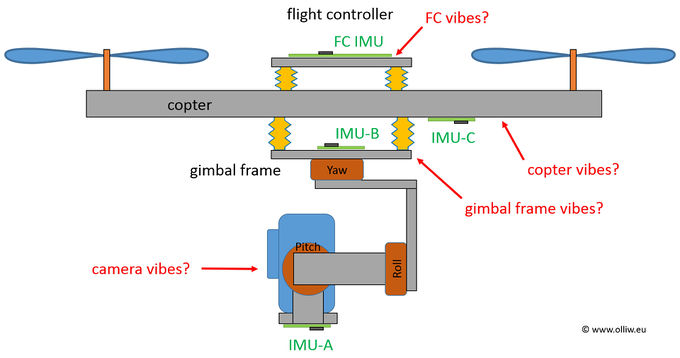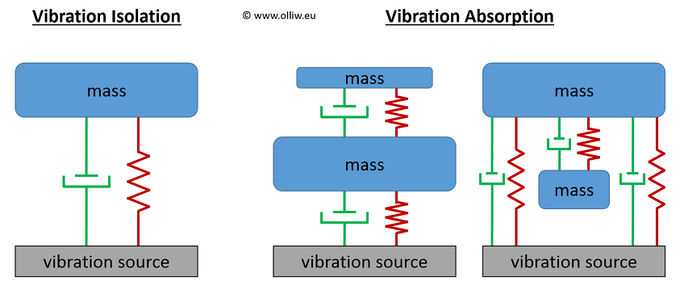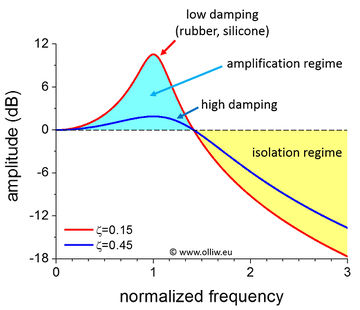Evaluating Vibrations and Optimizing Damper Systems
For aerial video applications, one of the most difficult aspect of a DIY gimbal system is to achieve a low level of vibration and a well working damping system. The first reaction of most users to artefacts such as micro vibs or jello in the video seems to be "better PID tuning", while in fact the secret sauce of a well working system usually lies not in the PID tuning, but the copter's vibration level and construction of the gimbal damping system.
Unfortunately, when it comes to the latter aspects the current approach available to us DIY guys is essentially trial-and-error, which at times can be frustrating.
Conceptional
The basic idea of a vibration and damping system analysis using IMUs is sketched in the following picture.
Flight controller often provide options for analyzing the copter's vibrations. However, the limitation is obvious: In most cases it does not see the real copter vibrations, since it is mounted with some dampers to the copter. Also, what matters to us are the vibrations at the camera, which is "far away" from the flight controller. That is, in a technical language, the transfer functions for the copter's vibrations to the flight controller and to the camera are substantially different. For a complete vibration analysis one needs to know the vibrations on the copter, on the gimbal frame, and the camera. It is pointed out that only with knowing the vibrations on the copter and the gimbal frame, the performance of a gimbal damping system can actually be assessed.
Comment: In order to avoid confusion, this clarification: In the above sketch the IMUs are numbered as IMU-A, IMU-B, and IMU-C, which is different to the usual terminology used by the STorM32 gimbal controller. This is so since, e.g., the 2nd IMU (in the terminology of the STorM32 gimbal controller) could be either IMU-B or IMU-C, depending on the user's setup. IMU-A is however IMU1.
The following video explains that, and also shows possible uses of the NTLoggerTool.
Comment: A 3rd IMU was supported in firmware versions v2.19e to v2.53, but is not available in firmware versions higher than v2.53. Some information in the video is thus obsolete.
Basic Physics
The physics of vibrations and damper systems is elementary, and quite many aspects can be properly inferred by applying basic laws of physics. Surprisingly, it seems very rarely been done. In this chapter only one simple, but crucial point shall be pointed out:
The vibration dampers, as we like to call them, do not actually damp vibrations.
Before explaining that, it may be useful to first introduce the two general approaches of vibration isolation and vibration absorption (this classification seems to be widely, but not generally, accepted):
Vibration Isolation: The system is separated from a vibrating source by some flexible pieces of something (which we call dampers). Physically it is described as to consist of a damping element, spring element, and a mass of payload.
Vibration Absorption: The system is separated from a vibrating source by some dampers, where in addition a second mass of payload is attached to the primary mass via some further dampers.
The gimbal damper system by itself constitutes a vibration isolation system. However, if the stiffness of the gimbal is taken into account, the copter + gimbal frame + camera system is rather reminiscent of a vibration absorption system (but with swapped roles of the masses). Anyway, let's assume a perfectly stiff gimbal, and let's talk about the gimbal dampers as a vibration isolation system.
Physically, the item which we commonly call a damper is a combination of a damping element and a spring element. The most crucial points to realize are these. First:
The damping coefficient of (most) vibration dampers is relatively low.
You may confirm that easily yourself by using google. The damping coefficient of e.g. rubber is somewhere in the range of few 0.1 or less. You may also easily confirm that by a simple test: Tip your gimbal, and you will see it swinging back and forth a couple of times. The necessary consequence of that is, second:
The vibration damper does not always reduce the vibrations. In some frequency range the vibrations are actually substantially amplified.
This latter point makes the gimbal damping issue so complicated, because a good vibration reduction in some frequency range is payed for by some substantial amplification in vibrations in a lower frequency range. The situation is shown in this picture:


